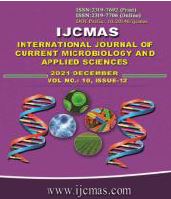


 National Academy of Agricultural Sciences (NAAS)
National Academy of Agricultural Sciences (NAAS)

|
PRINT ISSN : 2319-7692
Online ISSN : 2319-7706 Issues : 12 per year Publisher : Excellent Publishers Email : editorijcmas@gmail.com / submit@ijcmas.com Editor-in-chief: Dr.M.Prakash Index Copernicus ICV 2018: 95.39 NAAS RATING 2020: 5.38 |
In Jammu and Kashmir, a number of diseases like scab, Alternaria leaf blotch, Marsonena, sooty blotch, fly-speck and a number of post-harvest diseases pose a major threat to the apple industry. The occurrence of Alternaria leaf blotch in J&K was reported and the disease is prevalent in almost all the apple growing districts of Kashmir valley. Alternaria leaf blotch was considered a disease of minor importance in comparison to apple scab. However, the disease resulted in epidemic during summer of 2013, and about 40-60 per cent yield loss was reported. This epidemic was attributed to climate change ( high temperature coupled with prolonged rains), absence of disease forecasting system in the valley and also to the fact that currently used fungicides do not provide satisfactory level of disease control. When overwintering mycelium forms conidia and infects fresh budding apple leaves in the spring, the infection begins. After 90 days after flowering, a rise in temperature combined with significant rainfall and relative humidity enhances secondary infection in leaves and fruits. For disease control, a variety of techniques are available, including cultural, chemical, resistance, and biological approaches. We'll go through the disease's cause, symptoms, and treatment options here.
 |
 |
 |
 |
 |